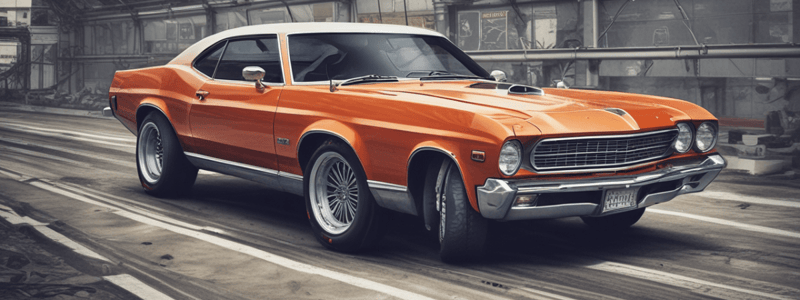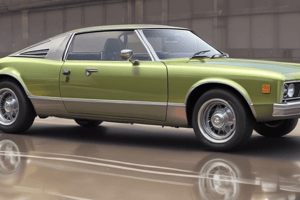Podcast
Questions and Answers
What is the classification of automobiles based on the number of wheels?
What is the classification of automobiles based on the number of wheels?
- On the basis of transmission
- On the basis of fuel used
- On the basis of wheels (correct)
- On the basis of load
Which type of vehicle has an engine located in the rear?
Which type of vehicle has an engine located in the rear?
- Truck
- Nano car (correct)
- Most of the cars
- Scooter
What is the type of vehicle classified as Heavy Transport Vehicle (HTV)?
What is the type of vehicle classified as Heavy Transport Vehicle (HTV)?
- Bus
- Car
- Heavy motor vehicle (HMV) (correct)
- Scooter
Which type of transmission does not require manual gear change?
Which type of transmission does not require manual gear change?
What is the type of vehicle classified as a four-wheeler?
What is the type of vehicle classified as a four-wheeler?
Which type of fuel is used by LPG and CNG vehicles?
Which type of fuel is used by LPG and CNG vehicles?
What are the two main units of an automobile?
What are the two main units of an automobile?
What is the term for the underlying framework or structure that supports various components such as the engine, suspension, brakes, and bodywork?
What is the term for the underlying framework or structure that supports various components such as the engine, suspension, brakes, and bodywork?
What type of chassis is commonly used in passenger cars and some SUVs?
What type of chassis is commonly used in passenger cars and some SUVs?
What is the lowest position of the piston towards the crank end side of the cylinder?
What is the lowest position of the piston towards the crank end side of the cylinder?
What is the inside diameter of the cylinder called?
What is the inside diameter of the cylinder called?
What is the function of the cylinder head gasket?
What is the function of the cylinder head gasket?
What is the term for the topmost position of the piston towards the cover end side of the cylinder?
What is the term for the topmost position of the piston towards the cover end side of the cylinder?
What is the superstructure of the vehicle that is bolted to the chassis?
What is the superstructure of the vehicle that is bolted to the chassis?
What is the purpose of the combustion chamber in an engine?
What is the purpose of the combustion chamber in an engine?
What is the function of the inlet manifold in an engine?
What is the function of the inlet manifold in an engine?
What is the purpose of the gudgeon pin in an engine?
What is the purpose of the gudgeon pin in an engine?
What is the function of the crankshaft in an engine?
What is the function of the crankshaft in an engine?
What is the primary function of piston rings in a gasoline engine?
What is the primary function of piston rings in a gasoline engine?
What is the purpose of the flywheel in a gasoline engine?
What is the purpose of the flywheel in a gasoline engine?
What is the primary function of the camshaft in a gasoline engine?
What is the primary function of the camshaft in a gasoline engine?
Why are diesel engines not preferred in commercial vehicles?
Why are diesel engines not preferred in commercial vehicles?
What is the primary advantage of diesel engines?
What is the primary advantage of diesel engines?
What is the purpose of the connecting rod in a gasoline engine?
What is the purpose of the connecting rod in a gasoline engine?
What is the primary benefit of using a diesel engine in a big diesel tractor-trailer rig?
What is the primary benefit of using a diesel engine in a big diesel tractor-trailer rig?
Which type of engine is commonly used in passenger cars and light trucks due to its balance of performance, efficiency, and compact size?
Which type of engine is commonly used in passenger cars and light trucks due to its balance of performance, efficiency, and compact size?
What is the primary purpose of engine balancing in internal combustion engines?
What is the primary purpose of engine balancing in internal combustion engines?
What type of engine balancing deals with the forces caused by the reciprocating masses?
What type of engine balancing deals with the forces caused by the reciprocating masses?
What is the purpose of balancing shafts in inline-4 engines?
What is the purpose of balancing shafts in inline-4 engines?
What is the advantage of using a Flat-4 (F4 or H4) engine in some sports cars and compact cars?
What is the advantage of using a Flat-4 (F4 or H4) engine in some sports cars and compact cars?
What is a primary benefit of engine balancing in terms of operation?
What is a primary benefit of engine balancing in terms of operation?
What is a key consideration in balancing high-performance engines?
What is a key consideration in balancing high-performance engines?
What is the main goal of dynamic balancing?
What is the main goal of dynamic balancing?
What is the purpose of the bobweight method in engine balancing?
What is the purpose of the bobweight method in engine balancing?
What is a key impact of engine balancing on engine components?
What is a key impact of engine balancing on engine components?
What is a modern development in engine balancing?
What is a modern development in engine balancing?
What is a key factor in achieving effective engine balance?
What is a key factor in achieving effective engine balance?
What is the primary reason engine balancing adds complexity to engine design and manufacturing?
What is the primary reason engine balancing adds complexity to engine design and manufacturing?
What is a key benefit of engine balancing in terms of performance?
What is a key benefit of engine balancing in terms of performance?
What is a key application of computational methods in engine balancing?
What is a key application of computational methods in engine balancing?
Flashcards are hidden until you start studying
Study Notes
Classification of Automobiles
- Automobiles are classified based on:
- Load: Heavy Transport Vehicle (HTV), Light Transport Vehicle (LTV), etc.
- Wheels: Two-wheeler, Three-wheeler, Four-wheeler, Six-wheeler, etc.
- Fuel used: Petrol, Diesel, Electric, Steam, Gas, etc.
- Body style: Sedan, Hatchback, Coupe, Station Wagon, Convertible, etc.
- Transmission: Conventional, Semi-automatic, Automatic
- Drive: Left-hand drive, Right-hand drive
- Driving axle: Front-wheel drive, Rear-wheel drive, All-wheel drive
Vehicle Construction and Components
- Main components of an automobile:
- Frame
- Chassis
- Body
- Power unit
- Transmission system
- Frame: The skeleton of the vehicle
- Types: Conventional, Semi-integral, Integral
- Chassis: The underlying framework of the vehicle
- Types: Body-on-Frame, Monocoque (Unibody), Backbone, Spaceframe, Platform
Engine Components
- Cylinder Block:
- Main supporting structure for engine components
- Cylinder head is mounted on top
- Crankcase is provided at the bottom
- Cylinder:
- Cylindrical vessel or space for piston movement
- Supported in the cylinder block
- Piston:
- Cylindrical component that fits into the cylinder
- Forms the moving boundary of the combustion system
- Combustion Chamber:
- Space enclosed in the upper part of the cylinder
- Fuel combustion takes place here
- Inlet Manifold:
- Pipe that connects the intake system to the inlet valve
- Air or air-fuel mixture is drawn into the cylinder
- Gudgeon Pin:
- Forms the link between the small end of the connecting rod and the piston
- Exhaust Manifold:
- Pipe that connects the exhaust system to the exhaust valve
- Products of combustion escape into the atmosphere
- Inlet and Exhaust Valves:
- Regulate the charge coming into the cylinder and the products of combustion
- Connecting Rod:
- Interconnects the piston and the crankshaft
- Transmits the gas forces from the piston to the crankshaft
- Crankshaft:
- Converts the reciprocating motion of the piston into useful rotary motion
- Enclosed in a crankcase
Gasoline Engine
- Basic parts of a gasoline engine:
- Cylinder block
- Piston
- Piston rings
- Piston pin
- Connecting rod
- Crankshaft
- Cylinder head
- Intake valve
- Exhaust valve
- Camshaft
- Timing gears
- Spark plug
Advantages and Disadvantages of Diesel Engines
- Advantages:
- Better fuel economy
- Longer engine life
- Disadvantages:
- Heavier and more expensive
- Lower maximum RPM ranges
- Must be fuel injected
- Produce more smoke
- Harder to start in cold weather
- Noisier and tend to vibrate
Multiple Cylinder Engines
- Common configurations:
- Inline engines (I2, I3, I4, I5, I6)
- V engines (V6, V8, V10, V12)
- Boxer (Flat) engines (F4, F6)
- Rotary engines
- Factors influencing engine configuration:
- Vehicle size
- Performance requirements
- Fuel efficiency goals
- Manufacturer preferences
Engine Balancing
- Importance of engine balancing:
- Smooth operation
- Minimize vibrations
- Optimize performance
- Types of engine balancing:
- Primary balancing (reciprocating masses)
- Secondary balancing (rotating masses)
- Methods of balancing:
- Balancing shafts
- Counterweights
- Engine layout optimization
- Benefits of engine balancing:
- Smooth operation
- Improved reliability
- Performance optimization
- Considerations in balancing:
- Engine speed and application
- Manufacturing tolerances
- Cost and complexity
- Balancing techniques:
- Dynamic balancing
- Bobweight method
- Modern developments:
- Active balancing systems
- Computational methods (CAD, simulation, CFD, FEA)
Studying That Suits You
Use AI to generate personalized quizzes and flashcards to suit your learning preferences.





